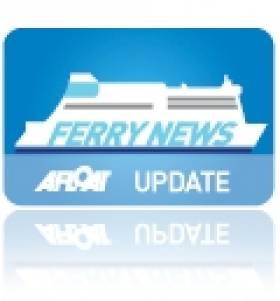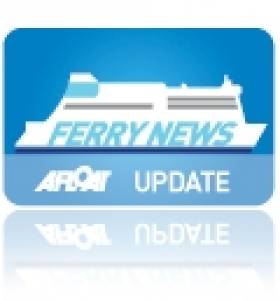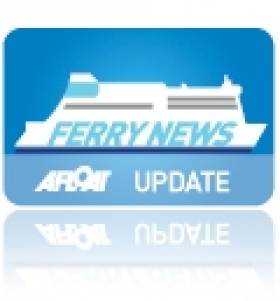Displaying items by tag: Dublin Swift
Ferry-Go-Round in Run-Up to Boost Capacity for Christmas
#FERRY BOOST - Irish Ferries French route cruiseferry Oscar Wilde as previously reported is to undergo its annual dry-dock maintenance next month, however, she is to operate Christmas and New Year sailings between Rosslare-Pembroke Dock, writes Jehan Ashmore.
In mid-October Afloat.ie reported that the Welsh route cruiseferry Isle of Inishmore is to transfer to Dublin-Holyhead route to boost capacity over the busy festive season.
Each of Isle of Inishmore's sailings will provide space for an additional 2,200 passengers and more than 850 cars. She will join the central corridor route's cruiseferry Ulysses and fast-ferry Jonathan Swift otherwise marketed as the Dublin Swift. For sailing schedules including separate panel for sailings served by Isle of Inishmore click this LINK.
Irish Sea rivals Stena Line are to bring back HSS fast-craft Dun Laoghaire-Holyhead sailings for 12 days over the festive and New Year period, for schedule click HERE. In addition Stena also operate year-round Dublin-Holyhead sailings using two conventional ferries marketed as Superferries.
Scottish Ferry Sailings Suffer Storm Disruption
#FERRY NEWS - With winds of up to 100mph, Scottish ferry sailings on the North Channel routes from Northern Ireland, have been affected with two cancellations on Stena's Belfast-Cairnryan services, according to Channel 4 News.
P&O had no reported cancellations on its Irish Sea routes but is advising passengers to check in normally and expect delays. In addition some Scottish domestic ferry services were cancelled on some routes operated by Caledonian MacBrayne, while other services were disrupted.
To read more about the weather disruption across the Scottish central belt remains which remains on-high alert for storms while Northern Ireland and the north of England are subject to a severe weather warning click HERE. For the latest weather visit www.metoffice.gov.uk/
Sailing updates from Stena Line's Belfast-Cairnryan service can be viewed by clicking HERE and for information on delays on Belfast-Liverpool service click HERE. For sailing updates on routes operated by P&O click this LINK.
For the rest of the Irish Sea ferry routes, including those operated by Stena Line and Irish Ferries it would be also advisable to check each route from the operator's websites.
Irish Ferries Dublin Swift fast-ferry sailings to and from Holyhead have been cancelled, though cruiseferry sailings remain operating. To keep updated visit the 24hrs sailing update posted on the homepage of www.irishferries.com and for Irish weather coverage by visiting www.met.ie
P&O Close Seasonally Operated Fast-Ferry Services
As for the remaining winter-serving fast-ferries they are Stena Line's HSS Stena Voyager (1996/ 19,638grt) between Belfast-Stranraer, in tandem with conventional ferries. Next month this route will close as the Scottish terminal relocates to a new ferryport nearby at (Loch Ryan Port) Cairnryan.
In addition two sister-ferries, which are undergoing modifications and an upgrade for their two-year charter on the North Channel, will directly replace the two-hour passage times it takes for the HSS fast-ferry and the ferries Stena Caledonia and Stena Navigator which take 2hrs 50 minutes.
With the introduction of the new tonnage to the Belfast-Cairnryan route, sailings times will be reduced to 2hrs 15mins. Ironically the new ferries which albeit will be the largest to serve on any North Channel route will actually be some 15 minutes slower on the newer-shorter distance route compared to the HSS fast-ferry operated Belfast-Stranraer sailings.
The second fast-ferry service is operated on Irish Ferries Dublin-Holyhead route using Jonathan Swift (1999/5,989grt) which is marketed as the Dublin 'Swift'. She runs year-round in addition to the cruiseferry Ulysses.
Also operating fast-ferry craft is the Isle of Man Steam Packet Company's Manannan (1998/5,029grt) but this is on the none cross-channel route between Douglas and Liverpool.
Irish Sea Cross Channel Fast-Ferry Services On Declining Trend
The third service between Belfast-Stranraer is in the hands of rivals Stena Line which maintain the HSS Stena Voyager (1996/19,638 grt) on sailings but only to around mid-November. She will be replaced by conventional sister-ships which will be introduced on the North Channel's newest port when services switch from Stranraer to a new terminal close to Cairnryan.
Finally the fourth fast-ferry is Irish Ferries marketed 'Dublin Swift' service which runs on the Dublin-Holyhead route served by Jonathan Swift (1999/5,989 grt). The craft built by Austal in Fremantle, operates alongside the conventional cruise-ferry Ulysses.
Stena Line's decision to terminate HSS Stena Explorer sailings between Dun Laoghaire-Holyhead this day last week follows fast-ferry Stena Lynx III's end-of-season Rosslare-Fishguard sailings earlier this month.
From next year, Dun Laoghaire-Holyhead sailings are to be seasonal-only and according to Stena Line they hope to resume fast-ferry sailings in April or May though no exact date has been set. Unlike the central corridor route which was entirely dependent on HSS operations, the Rosslare-Fishguard route remains operating year-round with the conventional ferry Stena Europe.
As a result of the discontinued fast-ferries, the HSS Stena Explorer is now spending a lay-up period in the Welsh port for the winter. The smaller Stena Lynx III is also 'wintering' but in on the opposite side of the Irish Sea in Dun Laoghaire, where the vessel has done so in previous years.
The lay-up of both fast-ferries in Dun Laoghaire and Holyhead is ironic considering that neither ports' are connected by the very craft that used to share sailing rosters in recent years. In addition the wintering of these catamaran craft is the first time that this has occurred since the pioneering Stena Sea Lynx fast-ferry launched such sailings in 1993.
This first 'Lynx' provided seasonal sailings on the route with conventional car-ferry Stena Hibernia, the former St. Columba, custom-built in 1977 for Sealink /British Rail. She was given a second name under Stena ownership, the Stena Adventurer and remained on the 57 nautical-mile route until replaced in 1996 by the year-round operated HSS Stena Explorer.
Apart from cross-channel fast-ferry services, the Isle of Man is served by the Isle of Man Steam Packet Co. Ltd's routes linking the islands capital Douglas with Belfast, Dublin, Heysham and Liverpool (Birkenhead) in the winter. These routes include seasonal services which are operated by a combination of conventional tonnage using Ben-My-Chree and fast-ferry Manannan (1998/5,089grt), a former US Navy vessel, to read more click HERE. For sailing schedules, vessel type deployed on route and for fares click HERE.
- Dublin Port
- Irish Ferries
- Dun Laoghaire
- Stena Europe
- Holyhead
- P&O Ferries
- Belfast Harbour
- Stena Line
- Larne
- Ports and Shipping News
- Ulysses
- P&O (Irish Sea)
- Cairnryan
- Ferry news
- Stena Explorer
- Stena Express
- FastFerries
- Cruiseferry
- Manannan
- Isle of Man Steam Packet Co.
- Stena Voyager
- Belast Port
- Isle of Man ferry services
- P&O Express
- Irish Sea fastferries
- Stena 'Lynx'
- BenMyChree
- Dublin Swift
- Stena Sea Lynx































































